- What is Ischaemic Maculopathy?
- Statistics
- Risk Factors
- Progression
- Symptoms
- Clinical Examination
- How is it Diagnosed
- Prognosis
- Treatment
- Ischaemic Maculopathy Prevention
- References
What is Ischaemic Maculopathy?
Ischaemic maculopathy is one of a group of eye diseases which affect diabetics. These eye diseases are collectively referred to as diabetic retinopathy.
Diabetic retinopathy occurs as a result of abnormal changes to the structure of blood vessels, which occur as a result of diabetes. In the early stages of the disease these changes affect the eye’s retina (retinopathy) and may be classified as either:
- Non-proliferative diabetic retinopathy – characterised by the growth of abnormal new blood vessels in the eye; or
- Proliferative diabetic retinopathy – characterised by bleeding from abnormal new blood vessels into the retina which can cause vision loss.
The changes which occur in proliferative and non-proliferative retinopathy may also affect the eye’s macula. This causes diabetic maculopathy, in which changes to the retina lead to the loss of capillaries in the macula. Diabetic maculopathy only occurs in diabetics affected by retinopathy; however it can occur even in the early stages of retinopathic disease, before the condition begins to affect vision or is diagnosed.
Diabetic maculopathy refers to two distinct eye diseases diabetic macular oedema and diabetic ischaemic maculopathy. The two types of maculopathy are often comorbid, that is; an individual with macular oedema also often has ischaemic maculopathy. Ischaemic maculopathy occurs in conjunction with macular oedema and may occur even when macular oedema is mild. Individuals with ischaemic maculopathy are at risk of severe vision loss and treatments for the condition which can prevent vision loss have not yet been developed.
 |
For more information about the structure and function of the eye, see The Eye and Vision. |
Statistics
Evidence of diabetic retinopathy is almost universal in individuals who have had diabetes for 30 years or more. All individuals with diabetic retinopathy are at risk of maculopathy, including ischaemic maculopathy.
Approximately 14% of diabetics have maculopathy, most commonly macular oedema, which typically precedes ischaemia if left untreated. One study which classified eyes according to type of retinopathy, reported 8% of eyes affected by retinopathy had some evidence of ischaemic maculopathy.
Risk Factors
Risk factors for diabetic macular ischaemia include:
- Diabetes control: the risk of ischaemic maculopathy is increased in diabetic individuals with poor diabetes control (i.e. control of blood sugar, blood pressure and other metabolic abnormalities characteristic of diabetes). In particular suboptimal blood pressure control has been linked to the development of ischaemic maculopathy;
- Type 2 Diabetes: diabetic maculopathy (either ischaemia or oedema) is more common in type 2, compared to type 1 diabetes;
- Injection of bevacizumab into the eye in the treatment of persistent diabetic macular oedema has been reported in one case to catalyse macular ischaemia.
 |
For more information about type 1 diabetes, see Diabetes Mellitus Type 1.
 |
For more information about type 2 diabetes, see Diabetes Mellitus Type 2.
Progression
Ischaemic maculopathy occurs as a complication of proliferative or non-proliferative diabetic retinopathy, conditions which cause microvascular changes (changes to tiny blood vessels) in the retina. Changes to the retina in turn affect the macula, for example they cause breakdown of capillary walls and/or enlargement or blockage of capillaries of the macula.
Ischaemic maculopathy occurs when changes such as enlargement or blockage affect the capillaries located near the fovea (a structure in the eye which processes colour and enables accurate, sharp vision). It can only occur when there is some degree of macular oedema and typically occurs when macular oedema is significant, following the loss of capillaries in the macula. In ischaemic maculopathy capillary loss affects the fovea and nearby areas and causes severe visual loss which does not respond to treatment.
Visual deterioration is often gradual and usually painless. As a result, an individual with ischaemic maculopathy may not notice their vision deteriorating.
Symptoms
The key symptom of ischaemic maculopathy is blurred vision. However there are often no visual symptoms until extensive damage to the capillaries of the macula has occurred.
Clinical Examination
All diabetics, including those with suspected ischaemic maculopathy should be screened for diabetic retinopathy. Clinical assessment to screen for diabetic retinopathy typically involves:
- A visual acuity test; and
- Examination of the eyes for signs of vessel damage by slit lamp biomicroscopy with dilated pupils. The pupils are dilated with eye drops.
Diabetics should have their eyes examined periodically to identify changes to the blood vessels indicative of diabetic retinopathy. They should also have their eyes examined promptly if their vision starts to deteriorate.
How is it Diagnosed
Ischaemic maculopathy is diagnosed using a technique called a fluorescein angiogram. This involves injecting a fluorescent dye into the blood vessels and taking an x-ray, on which the distribution of the dye is visible. By seeing how the dye distributes, the examiner can identify abnormalities in the blood vessel network and areas where blood vessels may be leaking.
Prognosis
Ischaemic maculopathy is a sight threatening condition for which there are currently no effective treatments. When an individual has ischaemic maculopathy it is more difficult to treat proliferative retinopathy with laser surgery. Laser treatment for retinopathy is unlikely to succeed when ischaemia of the macula is significant and if untreated, retinopathy is likely to worsen.
Vision loss is common. One study reported that 58% of diabetics with ischaemic maculopathy had visual acuity of ?20/100 (one fifth of normal visual acuity) after 3 years of disease.
Treatment
Ischaemic maculopathy is a sight threatening condition for which there is currently no effective treatment.
Diabetes control
Optimal diabetes control (including blood glucose control) is important for slowing the progression of diabetic retinopathy and maculopathy. In relation to ischaemic maculopathy; blood pressure lowering therapies are particularly important. However, blood pressure therapy should be introduced gradually; if the therapies implemented to control blood pressure cause changes too rapidly, they may temporarily cause ischaemic maculopathy to worsen.
Surgery
Ischaemic maculopathy cannot be treated with laser surgery.
Medicine
There are currently no medicines which have been shown to treat ischaemic maculopathy effectively. However, medicines may be developed in the future. Intravitreal injections (injections into the vitreous of the eye) of a medicine called triamcinolone have been used successfully to treat other eye conditions characterised by abnormal blood vessel growth and hold promise in the treatment of ischaemic maculopathy.
Support services for individuals with severe visual deterioration
Visual loss is common in ischaemic maculopathy. Individuals with visual acuity <3/60 in their better eye can register as legally blind. Those with visual acuity of <6/60 may register as partially sighted. This may assist in accessing appropriate support services. Individuals who fail to respond to treatment may also be referred to professional support services such as vision rehabilitation, social services and counselling to assist them in adapting to life with impaired vision.
More information
 |
For more information on diabetes, including different types of diabetes, blood glucose and dietary control, and long-term complications, as well as some useful videos, see Diabetes. |
Ischaemic Maculopathy Prevention
Prompt treatment of proliferative retinopathy may help prevent maculopathy. Optimal diabetes control can also prevent progression of macular oedema to ischaemic maculopathy and blood pressure control is a particularly important component of diabetes control for preventing ischaemic maculopathy.
References
- Tabandeh H, Goldberg M. The Retina in Systemic Disease: A colour manual of ophthalmoscopy. New York, NY: Thieme Medical Publishers; 2010: 91-108. [Book]
- Watkins PJ. Retinopathy. BMJ. 2003;326(7395):924-6. [Abstract | Full text]
- Guidelines for the management of diabetic retinopathy [online]. Canberra, ACT: National Health and Medical Research Council; 2008 [cited 28 February 2011]. Available from: URL link
- Bandello F, Battaglia Parodi M, Lanzetta P, et al. Diabetic macular edema: Rationale for therapy. In: Coscas G, Cunha-Vaz J, Loewenstein A, Soubrane G (eds). Macular Edema: A practical approach. Developments in Ophthalmology Vol 47. Basel: Karger; 2010: 73-110. [Book]
- Cardillo Piccolino F, Zingirian M, Mosci C. Classification of proliferative diabetic retinopathy. Graefes Arch Clin Exp Ophthalmol. 1987;225(4):245-50. [Abstract]
- Scanlon PH. Chapter 6: Stage M1: Maculopathy. In: Scanlon PH, Wilkinson CP, Aldington SJ, Matthews DR (eds). A Practical Manual of Diabetic Retinopathy Management. Oxford: Wiley-Blackwell; 2009: 74. [Book]
- Goel N, Kumar V, Ghosh B. Ischemic maculopathy following intravitreal bevacizumab for refractory diabetic macular edema. Int Ophthalmol. 2011:31(1): 39-42. [Abstract | Full text]
- Viswanath K, McGavin DD.Diabetic retinopathy: Clinical findings and management. Community Eye Health. 2003;16(46):21-4. [Full text]
- Joussen AM, Kirchhof B. Chapter 2: Therapeutic approaches to macular oedema. In: Kirchhof B, Wong D (eds). Vitreo-Retinal Surgery. Germany: Springer-Verlag; 2005: 13-28. [Book]
- Kent D, Campochiaro PA. Chapter 22: The eye: Diabetic retinopathy/ophthalmopathy. In: Sperling MA (ed). Type 1 Diabetes: Etiology and treatment. Totowa, NJ: Humana Press; 2003: 393-408. [Book]
- Williams G. Chapter 12.11.1: Diabetes. In: Warrell DA, Cox TM, Firth JD (eds). Oxford Textbook of Medicine, Vol 2 (4th edition). Oxford: Oxford University Press; 2005: 347-50. [Book]
- Ockrim Z, Yorston D. Managing diabetic retinopathy. BMJ. 2010;341:c5400. [Abstract]
- Studholme S. Diabetic retinopathy. JJ Perioper Pract. 2008;18(5):205-10. [Abstract]
- Nagpal M, Wartikar S. Chapter 25: Proliferative diabetic retinopathy. In: Agarwal A (ed). Fundus Fluorescein and Indocyanine Green Angiography: A textbook and atlas. USA: Slack Incorporated; 2008: 207-14. [Book]
- Byeon SH, Chu YK, Lee H, et al. Foveal ganglion cell layer damage in ischemic diabetic maculopathy: Correlation of optical coherence tomographic and anatomic changes. Ophthalmology. 2009;116(10):1949-59. [Abstract]
- Diabetic retinopathy: Initial and follow-up evaluation [online]. San Francisco, CA: International Council of Ophthalmology; 3 January 2011 [cited 22 February 2011]. Available from: URL link
All content and media on the HealthEngine Blog is created and published online for informational purposes only. It is not intended to be a substitute for professional medical advice and should not be relied on as health or personal advice. Always seek the guidance of your doctor or other qualified health professional with any questions you may have regarding your health or a medical condition. Never disregard the advice of a medical professional, or delay in seeking it because of something you have read on this Website. If you think you may have a medical emergency, call your doctor, go to the nearest hospital emergency department, or call the emergency services immediately.







